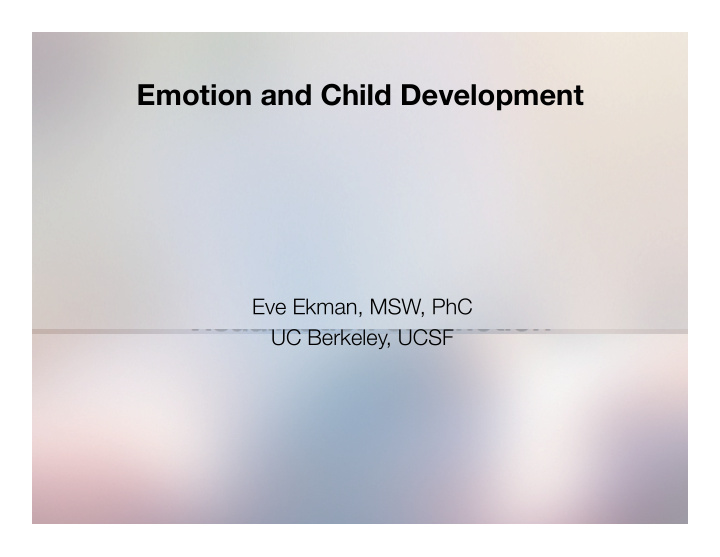



Emotion and Child Development Eve Ekman, MSW, PhC UC Berkeley, UCSF
Overview • Science of Emotion and Stress • Early childhood Development of Emotion, Empathy and Pro-Social Behavior • Adolescence, Risk Taking and Emotion Regulation • Take Away: Emotion Regulation and the Scope of Stress
Emotion Definition � Emotion is a process, a particular kind of automatic appraisal influenced by our evolutionary and personal past, in which we sense that something important to our welfare is occurring, and a set of physiological changes and behaviors begin to deal with the situation. In particular, emotions are thought to have arisen because they efficiently co-ordinate diverse response systems, thereby helping us respond to important challenges or opportunities.
Displays of Emotions Expressed on the face Felt inside the body Emerging from external and internal stimulus Communication with others Individual Differences
Expressed on the Face
Emotion Regulation – Re-Appraisal – Watch – Suppression • Finger Pulse Amplitude and Sympathetic Activation • Emotion Regulation= monitoring, evaluating and modifying emotion reactions(intensity-duration) towards a goal
Emotion + Intensity+ Density+ Frequency = Over-Arousal Stress Intensity/ Density Frequency
Threat vs. Challenge Stress Appraisal Perceived Perceived Demands Resources Fight Stasis Threat Challenge Boredom Flight Freeze Optimal Performance Lazarus & Folkman, 1984, Akinola & Mendes 2012, Dickerson & Kemmeny 2004
When do we start reading expressions of emotion? • One day • One Month • One Year • Two Years
Early Childhood Emotion Development • First five months: involuntary attention to faces, response to emotional display of others and sympathetic distress to the crying of other infants. • 9-12: months emotional information is sought from adult faces and responded to. • 24 months: infants are able to respond to another person’s distress with helping, comfort and sharing.
Still Face Paradigm � http://www.youtube.com/watch?v=apzXGEbZht0 • One Year of Age • Two Minutes
Development of Pro-Social Behavior ¡ Development of Pro Social Behavior:4 to 5 years through adulthood • Altruism • Empathy • Attachment Social Referencing • Using parents to make decisions • Begins with a visual cliff and goes on to adolescent decisions
Social Referencing • http://www.youtube.com/watch?v=p6cqNhHrMJA
Adolescent Brain • Behavioral/Social/Context Interactions • The neuro-behavioral changes – Motivation à and Emotion • More frequent and Intense Emotions • Plasticity similar to the 0-3 development phase – skill development increased
Risk Taking Behavior, Reward and Emotion Regulation + Risk sensation & intensity, seeking + Increased reward-seeking, (especially in the presence of peers) + Remodeling of the brain’s dopaminergic system = Reckless Behavior
The Adolescent Brain, Risk and Opportunity The adaptive potential of • the overproduction/ selective elimination process, • increased connectivity and integration of disparate brain functions, changing reward systems and frontal/limbic balance, • and the accompanying behaviors of separation from family of origin, increased risk taking, and • increased sensation seeking have been highly adaptive in our past and may be so in our future. These changes and the enormous plasticity of the teen brain make adolescence a time of great risk and great opportunity” Jay N. Giedd, The Teen Brain: Insights from Neuroimaging, Journal of Adolescent Health, Volume 42, Issue 4, April 2008, Pages 335-343,
Stress, Emotion and Awarness • For Parents • For Youth • Creating the emotionally aware environment
Emotion + Intensity+ Density+ Frequency = Over-Arousal Stress Intensity/ Density Frequency
Threat vs. Challenge Stress Appraisal Perceived Perceived Demands Resources Fight Stasis Challenge Threat Boredom Flight Freeze Optimal Performance Lazarus & Folkman, 1984, Akinola & Mendes 2012, Dickerson & Kemmeny 2004
Scope of Chronic Stress Impact on Clients Impact on Co- Workers Individual Impa ct ¡ ¡ ¡
Scope of Chronic Stress Impact on Kids Impact on Family Individual Impa ct ¡ ¡ ¡
Scope of Emotion Availability and Attention Impact on Kids Impact on Family Individual Impa ct ¡ ¡ ¡
• Neuroplasticity Science of meditation and emotion • Stress Reduction ¡ • Mind Body Connection • Basic Goodness • Altruism • Elevation • Empathy • Compassion ¡ ¡
THANK YOU
Recommend
More recommend